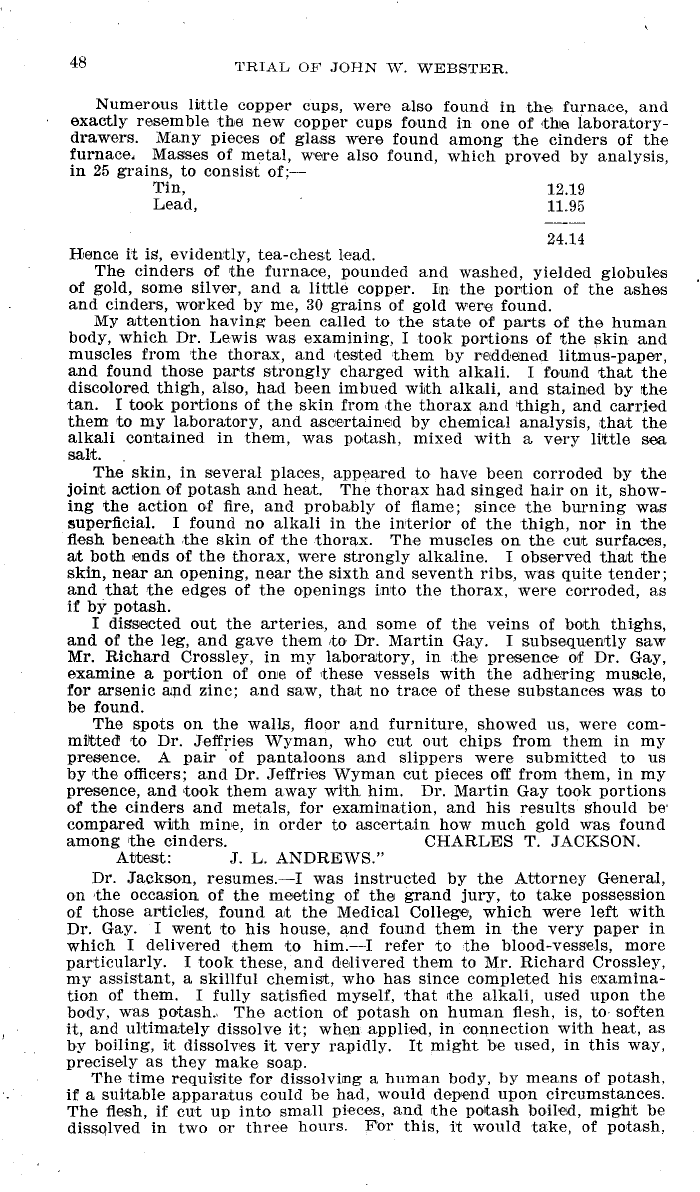|
48 TRIAL OF JOHN W. WEBSTER.
Numerous little copper cups, were also found in the furnace, and
exactly resemble the new copper cups found in one of ~thie laboratory-
drawers. Many pieces of glass were found among the cinders of the
furnace. Masses of metal, were also found, which proved by analysis,
in 25 grains, to consist of;
Tin, 12.19
Lead, 11.95
24.14
Hence it is, evidently, tea-chest lead.
The cinders of the furnace, pounded and washed, yielded globules
of gold, some silver, and a little copper. In the portion of the ashes
and cinders, worked by me, 30 grains of gold were found.
My attention having been called to the state of parts of the human
body, which Dr. Lewis was examining, I took portions of the skin and
muscles from the thorax, and :tested them by reddened litmus-paper,
and found those parts strongly charged with alkali. I found that the
discolored thigh, also, had been imbued with alkali, and stained by the
tan. I took portions of the skin from the thorax and thigh, and carried
them to my laboratory, and ascertained by chemical analysis, that the
alkali contained in them, was potash, mixed with a very little sea
salt.
The skin, in several places, appeared to have been corroded by the
joint action of potash and heat. The thorax had singed hair on it, show-
ing the action of fire, and probably of flame; since the burning was
superficial. I found no alkali in the interior of the thigh, nor in the
flesh beneath ,the skin of the thorax. The muscles on the cut surfaces,
at both ends of the thorax, were strongly alkaline. I observed that the
skin, near an opening, near the sixth and seventh ribs, was quite tender;
and that the edges of the openings into the thorax, were corroded, as
if by potash.
I dissected out the arteries, and some of the veins of both thighs,
and of the leg, and gave them to Dr. Martin Gay. I subsequently saw
Mr. Richard Crossley, in my laboratory, in the presence of Dr. Gay,
examine a portion of one of these vessels with the adhering muscle,
for arsenic and zinc; and saw, that no trace of these substances was to
be found.
The spots on the walls, floor and furniture, showed us, were com-
mitted to Dr. Jeffries Wyman, who cut out chips from them in my
presence. A pair of pantaloons and slippers were submitted to us
by the officers; and Dr. Jeffries Wyman cut pieces off from them, in my
presence, and took them away with him. Dr. Martin Gay took portions
of the cinders and metals, for examination, and his results should be-
compared with mine, in order to ascertain how much gold was found
among the cinders. CHARLES T. JACKSON.
Attest: J. L. ANDREWS."
Dr. Jackson, resumes.-I was instructed by the Attorney General,
on -the occasion of the meeting of the grand jury, to take possession
of those articles, found at the Medical College, which were left with
Dr. Gay. I went to his house, and found them in the very paper in
which I delivered them to him.-I refer to the blood-vessels, more
particularly. I took these, and delivered them to Mr. Richard Crossley,
my assistant, a skillful chemist, who has since completed his examina-
tion of them. I fully satisfied myself, that ithe alkali, used upon the
body, was potash., The action of potash on human flesh, is, to soften
it, and ultimately dissolve it; when applied, in connection with heat, as
by boiling, it dissolves it very rapidly. It might be used, in this way,
precisely as they make soap.
The time requisite for dissolving a human body, by means of potash,
if a suitable apparatus could be had, would depend upon circumstances.
The flesh, if cut up into small pieces, and the potash boiled, might be
dissolved in two or three hours. For this, it would take, of potash,
|

